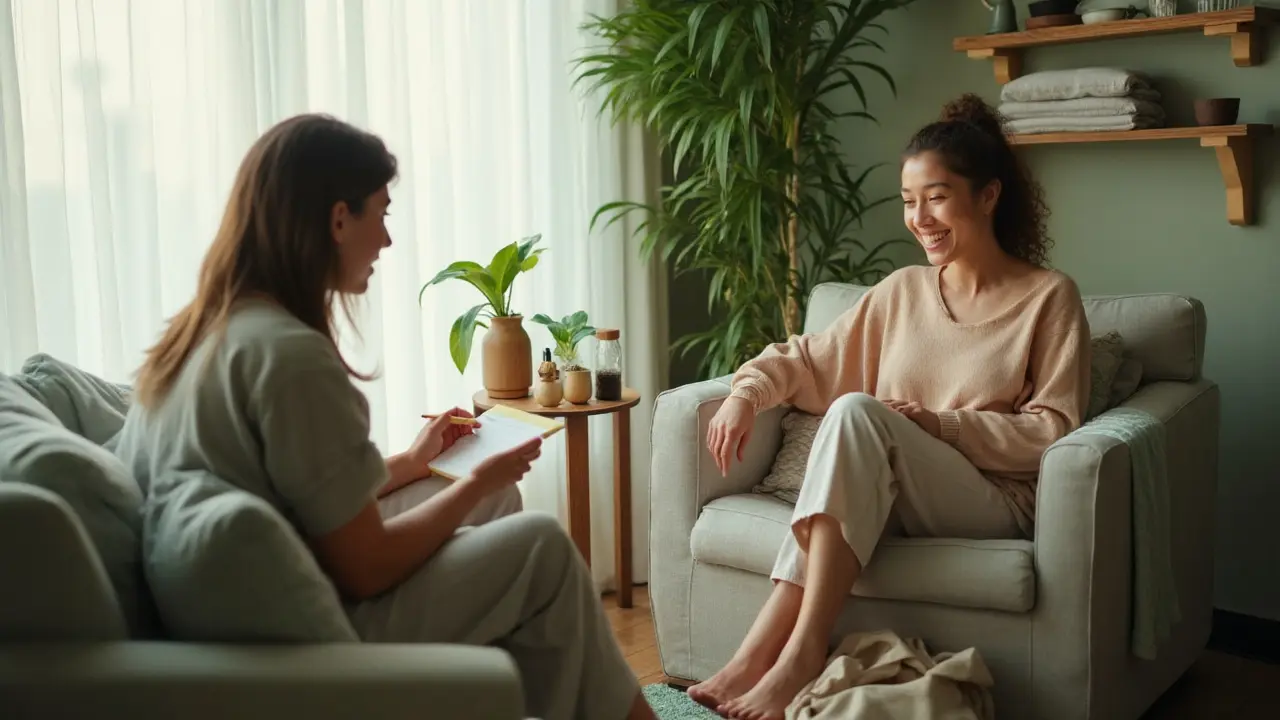Stress shows up in your body before it announces itself in your head-tight neck, shallow breathing, that wired-but-tired feeling at night. A good relax massage shuts that loop down fast. This guide keeps it real: what it actually does, how a session flows, how to pick the right therapist, and the simple tricks that make the calm last beyond the table.
TL;DR
- A relax massage (think Swedish-style) settles your nervous system, softens muscle tension, and improves sleep-without the pain of deep tissue work.
- It’s best for stress, mild aches, desk stiffness, and nervous system reset. Not a fix for acute injuries or severe mobility issues.
- Expect light-to-moderate pressure, slow strokes, steady rhythm, warm oil/lotion, and modest draping. Speak up about pressure and areas to avoid.
- Prep: hydrate, light snack, arrive 10 minutes early, clear your asks and boundaries. After: drink water, move gently, sleep early.
- Pick therapists by credentials, vibe, hygienic space, clear pricing, and how well they listen. Red flags: no intake form, pushy upsells, poor draping.
What Is a Relax Massage and Why It Works
When people say “relaxation massage,” they usually mean a Swedish-based session focused on calming the nervous system, easing muscle tension, and improving circulation. Pressure is typically light to medium, the pace is unhurried, and the goal is to dial down sympathetic arousal (your fight-or-flight) and bring up parasympathetic tone (rest-and-digest). If deep tissue is a workout, this is a slow exhale.
What you’ll feel: long gliding strokes, gentle kneading, rhythmic tapping now and then, and warm oil or lotion to reduce drag. The entire routine is designed to send your brain a message: you’re safe; you can let go. That message ripples into slower breathing, lower heart rate, and looser muscles.
Does it actually help? Yes, and it’s not just vibes. The National Center for Complementary and Integrative Health (NCCIH) has summarized evidence showing massage can reduce short-term anxiety and muscle soreness and improve perceived well‑being. The American College of Physicians’ 2017 guideline lists massage as an option for acute and subacute low back pain. Reviews published between 2019 and 2023 report small-to-moderate reductions in anxiety and pain intensity after a course of sessions, especially when people are consistent (weekly or biweekly for a few weeks).
What it won’t do: fix a herniated disk, correct your posture overnight, or detox your body (your liver and kidneys already handle that). It also isn’t the right tool for acute injuries, infections, fever, deep vein thrombosis, or uncontrolled cardiovascular issues. When in doubt, clear it with your physician, and tell your therapist what’s going on.
Who it’s best for: desk workers with tight traps and forearms, parents running on little sleep, athletes between events who want recovery without heavy pressure, and anyone stuck in a high-alert loop from stress. If you clench your jaw or wake up with shoulders kissing your ears, relaxation work can be a reset button.
How it fits with other modalities:
- Relaxation vs. Deep Tissue: Deep tissue targets adhesions and stubborn knots with slow, firm pressure and often some discomfort. Relaxation prioritizes nervous system downshift over intensity. If you’re sore for days after deep tissue, switch.
- Relaxation vs. Sports Massage: Sports is goal-oriented-ROM testing, targeted muscle work, event prep/recovery. Relaxation is whole‑body calm with optional focus areas.
- Relaxation vs. Hot Stone: Stones add heat that melts superficial tension faster. Great for winter or chronic chill. Not ideal if you’re heat-sensitive.
- Relaxation vs. Aromatherapy: Scent is optional; it helps some people unwind. If fragrances trigger headaches, go unscented and keep the core benefits.
Quick rule of thumb: if stress is the main villain, start with relaxation. If you’ve got a specific mechanical problem from training or injury, consider targeted work after your nervous system is out of fight-or-flight. Calm body, clearer diagnostics.

How to Prepare, What Happens, and How to Get the Most From It
I’ve had sessions that felt like a warm nap and others that flipped a switch on a headache in 15 minutes. The difference wasn’t magic-it was prep, clear asks, and a therapist who listened. Here’s how to stack the deck.
Before your session
- Hydrate without chugging. A glass of water 60-90 minutes before is perfect.
- Eat light. A banana, yogurt, or small sandwich is enough. Heavy meals make it hard to lie prone.
- Arrive 10 minutes early. Rushing spikes cortisol and steals the first 20 minutes of calm.
- Set an intention. One line works: “I want to sleep better tonight,” or “Please focus on neck and forearms.”
- Clothing: Wear easy-on/off layers. No need to overthink it.
- Health disclosures: Mention recent injuries, allergies, pregnancy, blood thinners, or skin issues. You’re not oversharing-you’re helping them keep you safe.
What actually happens during a standard 60-90 minutes
- Intake chat (2-5 minutes). You share goals and any concerns. A good therapist asks follow-ups. If they don’t, that’s a note.
- Private change and draping. You undress to your comfort level; you’re covered by a sheet/blanket except the area being worked. This is standard. If anything feels off, say so.
- Warm-up strokes. They apply oil/lotion with long, light passes to spread product and orient your system.
- Rhythmic flow. Expect slow, steady pressure that invites your muscles to let go. Most therapists keep conversation minimal unless you lead.
- Breathing cues. You might hear “take a deep breath” before they ease a tight spot. Follow it; it helps.
- Flip and finish. At halftime, you’ll turn over with help from the sheet. Final minutes often focus on neck, scalp, and shoulders-high-return zones.
- Gentle exit. They leave the room so you can get up slowly. Avoid popping up-your blood pressure needs a beat.
Pressure and pain scale
- 0-2: Barely there. Great for nervous-system reset, not for knot hunting.
- 3-4: Pleasant pressure, “ahh” zone. Sweet spot for most relaxation work.
- 5-6: Deep but not painful. Use sparingly for stubborn areas.
- 7+: Counterproductive for relaxation. Your body braces; the calm vanishes.
How to speak up without killing the vibe
- “Can we go one step lighter on pressure?” Short, specific, easy to apply.
- “Please skip my calves today-sore from running.”
- “No scents for me, I get headaches.”
- “Can you add a pillow under my hips?” (Helps low-back comfort when face-down.)
Post-session care that actually extends the calm
- Water-but normal amounts. You don’t need to flush toxins; you need to stay comfortably hydrated.
- Gentle movement. A 10-minute walk locks in circulation gains and prevents post-table stiffness.
- Heat at home. Warm shower or a heating pad for 10-15 minutes on your trouble spot keeps tissues pliable.
- Sleep window. Aim for a bedtime within 2-3 hours of your usual; you’ll fall asleep faster. Don’t sabotage it with screens.
- Micro-breaks next day. 60-90 seconds every hour to roll shoulders, open chest, and breathe 5 slow cycles. It prolongs the effect better than one long stretch.
At-home in-betweeners (when you can’t get a full session)
- Box breathing: inhale 4, hold 4, exhale 6-8, hold 2. Three rounds calm your nervous system fast.
- Neck release: tennis ball in a sock against the wall. Find a tender spot below the skull, hold 30 seconds, then slowly nod yes/no.
- Forearm flush: lotion on your hands, slow strokes from wrist toward elbow for 1-2 minutes each side. Desk workers: this is gold.
- Hot-cold contrast shower: 60 seconds warm, 30 seconds cool, repeat 3 times. You’ll feel looser and more awake without coffee.
How often should you go?
- High stress, poor sleep: weekly for 3-4 weeks, then biweekly or monthly maintenance.
- Desk tension, mild aches: every 2-3 weeks keeps you from backsliding.
- Budget-limited: go monthly and add 2× weekly home mini-sessions (breath, ball, and 10-minute walk).
What to expect to feel afterward
- Looser neck/shoulders, quieter mind, deeper sleep that night.
- Maybe mild soreness the next day in areas that were tight-like post-yoga soreness. Walk it off; it fades in 24 hours.
- If you feel dizzy right after, sit, sip water, and stand up slowly. Your blood pressure just shifted.

Choosing the Right Therapist and Style (Plus Checklists, FAQs, Next Steps)
A great session is equal parts skill and fit. You want someone who listens, keeps you comfortable, and works with your goals-not a one‑speed routine.
Decision criteria that matter
- Credentials and standards: Look for licensure or certification recognized where you live, plus visible hygiene standards (clean linens, sanitizer, handwashing).
- Listening and boundaries: They ask about goals, areas to focus/avoid, and pressure preferences. They explain draping and check in.
- Style match: You want slow, rhythmic, light-to-medium work with optional add‑ons (heat, scent). If you hate chatter, say so.
- Environment: Warm room, adjustable face cradle, calm music at conversation volume, no strong scents unless requested.
- Transparent pricing and terms: Clear rates for 60/90 minutes, what’s included, and cancellation policy.
Red flags-walk away if you see these
- No intake form or questions beyond “Full body?”
- Poor draping or dismissive attitude toward your comfort.
- Pressure ignored after you ask for changes.
- Unsanitary setup-stained linens, oily floor, cold room with no fix.
- Pushy upsells or mystery fees at checkout.
Simple choice guide: which style fits your day
- Need to sleep tonight: Relaxation or hot stone, low music, unscented oil.
- Big presentation at 4 p.m.: Relaxation with scalp and foot focus, finish 3-4 hours beforehand.
- Post‑run leg heaviness: Relaxation with extra time on calves and hips, light pressure flush, gentle stretches.
- Jaw clenching/tech neck: Relaxation with face, jaw, and chest opening; ask for lighter work around the TMJ.
Etiquette and clarity make it easy
- Arrive clean and on time; late starts shorten the session.
- Talking is optional. Silence is fine; you won’t offend anyone.
- Tipping: If customary where you live and the session isn’t already inclusive, 15-20% is common. If tips aren’t part of the culture, a sincere thank‑you and rebooking is perfect.
- Boundaries: You always control what’s touched, how it’s touched, and whether a technique continues. Say “please skip that” and it should stop immediately.
Price ranges and session length
- 60 minutes: typical baseline. Enough for full-body calm with one or two focus areas.
- 90 minutes: best value for deep relaxation. Adds detail work without rushing.
- 120 minutes: for rare treat days or if you unwind slowly.
Checklist: pre-session
- One sentence goal ready (“Focus neck and low back; lighter pressure.”)
- Hydrated, light snack, bathroom break.
- Allergies/conditions noted (e.g., fragrance, latex, pregnancy).
- Phone on Do Not Disturb; smartwatch off.
- Clothes easy to change; hair tie if you prefer oil-free hair.
Checklist: post-session
- Stand up slowly; sit if lightheaded.
- Small glass of water; 10-minute walk later.
- Block 30 calm minutes (no urgent calls) to let the reset stick.
- Note what worked (pressure, music volume, add‑ons) for next time.
Risks and how to avoid them
- If you bruise easily or take blood thinners, ask for lighter pressure and avoid deep work on calves/forearms.
- Pregnancy: seek a therapist trained in prenatal massage; side-lying positions are more comfortable and safer in later trimesters.
- Recent injury, fever, infection, or skin rash: postpone and consult your clinician. Massage can worsen acute conditions.
- Chronic pain flares: start with 50-60 minutes at light pressure, focus on nervous-system calming before any local work.
Mini‑FAQ
Does massage detox my body? Your liver and kidneys handle detox. Massage boosts circulation and lymph flow, which can help swelling and recovery, but it doesn’t purge toxins.
Can I talk during the session? Sure. Many people drift into silence because the brain downshifts. If you want quiet, say “I’d love a silent session today.”
What should I wear? Undress to your comfort level. You’ll be properly draped. If you keep underwear on, the therapist will work around it.
Will I be sore? Mild soreness is normal if an area was tight. It fades in 24 hours. Gentle movement and a warm shower help.
How often should I go? High stress or poor sleep: weekly for a few weeks, then taper. Otherwise, every 2-4 weeks is a sweet spot for maintenance.
Is it safe with medical conditions? Many conditions are compatible with modified massage, but disclose everything. For clots, uncontrolled blood pressure, fever, or infections, skip and talk to your clinician first.
Common mistakes to avoid
- Chasing deep pressure when your nervous system needs calm. If you brace, it’s too much.
- Not speaking up about pressure or temperature. Therapists aren’t mind readers.
- Scheduling back-to-back with stressful errands. Give yourself a landing strip.
- Skipping water and movement after. You’ll feel foggy instead of refreshed.
Next steps
- If you’ve never tried it: Book 60 minutes, light-to-medium pressure, with extra time on your top two tight spots. Keep it unscented the first time.
- If you’ve had mixed results: Switch therapists or clearly set the “calm-first” goal at intake; ask for slower pace and less chatter.
- If you’re training hard: Use relaxation work 24-48 hours after intense sessions to recover without adding stress.
- If budget is tight: Go monthly and stack the at-home mini routine (breath, ball, 10-minute walk) 3-4 times a week.
Troubleshooting by scenario
- “I felt anxious on the table.” Ask for slower, lighter strokes, warmer room, and no music with lyrics. Try a shorter session first.
- “I got a headache after.” You may be sensitive to scents or face cradle pressure. Go unscented next time and ask for a softer, better‑angled cradle with a folded towel under your forehead.
- “I was sore for two days.” Pressure was too deep or work was too focused. Dial down intensity and spread attention across the whole back and hips.
- “I didn’t feel much.” Ask for one level more pressure, slower pace, and longer holds on tight areas like traps and hip flexors.
- “I struggled to sleep that night.” Book earlier in the day, avoid caffeine after noon, and add 5 minutes of box breathing in bed.
Final thought: your body reads safety before it releases tension. The right therapist, the right pace, and a couple of small advocacy lines from you-“slower please,” “lighter pressure,” “unscented oil”-are the difference between a nice hour and the kind of reset that quietly changes your week.







When you curate a relaxation session, the ambience should read like a boutique hotel lobby rather than a budget clinic; think muted lighting, cedar scent, and a therapist who can articulate the proprioceptive benefits of a Swedish glide. Choose a practitioner who holds a recognized licensure and can discuss the neurochemical cascade that follows a gentle stroke-serotonin, oxytocin, the whole symphony. A superficial intake form is a red flag; you deserve a detailed questionnaire that probes both musculoskeletal history and stress triggers. Hydration before the table isn’t just a tip; it signals a commitment to circulatory health that amplifies the massage’s efficacy. And, of course, tip with the dignity of someone who respects artisanal service.
Many spa operators masquerade as healers while secretly selling the illusion of wellness, a practice that borders on intellectual fraud. If a therapist glosses over intake details and jumps straight to oil, they are compromising the very ethics of informed consent. The guide’s checklist is solid, but it fails to condemn the commodification of “relaxation” that strips the experience of cultural context. A truly respectful session would acknowledge the lineage of Swedish techniques rather than rebrand them as a trendy commodity. Remember, profit should never eclipse the patient’s autonomy.
First off, kudos for diving deep into the nuances of relaxation massage; it shows a willingness to invest in self‑care, which is commendable. When you arrive at the clinic, take a moment to scan the room for cleanliness-sterile linens, hand‑washing stations, and a calm décor set the tone for safety. If you notice any deviation, it’s perfectly acceptable to voice your concerns; a professional will appreciate your attentiveness. During the intake, be explicit about any recent injuries, medications, or allergies; this information helps the therapist tailor pressure and avoid contraindicated areas. It’s also wise to mention your stress goals, such as “improve sleep” or “reduce neck tension,” so the session can be purpose‑driven. Hydration before the massage should be moderate, about one glass of water 60‑90 minutes prior, to support lymphatic flow without causing discomfort during the session. Post‑massage, drinking another glass of water aids in flushing out metabolic waste that the massage may have mobilized. Gentle movement after the table-think a ten‑minute walk or light stretching-locks in circulation improvements and prevents stiffness. If you experience mild soreness the next day, view it as a sign that tight muscles have been engaged; a warm shower or light foam‑rolling can expedite recovery. When it comes to pressure, the 0‑2 scale is ideal for pure relaxation; however, if you feel you need a tad more depth, communicate “a little firmer on my upper back” and watch the therapist adjust. Remember that draping is a matter of dignity; the therapist should cover you appropriately and only expose the area being worked on. If you ever feel cold, ask for a blanket or a quick heat pack-comfort is paramount. Lastly, keep a brief journal of each session: note pressure level, areas treated, and how you felt afterward. This log becomes a valuable reference for future appointments and helps you track progress toward your wellness goals.
We chase calm like a mirage in the desert of our own making and a gentle stroke is the oasis we long for
Seeing how many practical tips you’ve gathered makes me feel hopeful that anyone can turn stress into serenity with just a bit of intention. The idea of setting a one‑sentence goal before the session is pure gold-it gives the therapist a compass and the mind a mantra. Adding simple at‑home rituals like a ten‑minute walk or box breathing can extend that mellow vibe for days, not just hours. Keep spreading these accessible hacks; the more people that try, the brighter the collective mood becomes.
the guide says “drink water, move gently, sleep early” which is okay but you could say “drink water, move gently, and sleep early” to make it a proper list it reads better also avoid run‑on sentences keep it short and clear
Oh, the agony of choosing the perfect therapist-it's almost as hard as picking a Netflix series after a long day, right? Honestly, if the room smells like a spa and the therapist actually listens, you’ve already won the day. Remember, you’re not there to endure a yoga class in disguise; you’re there to let go, so feel free to ask for lighter pressure and a quiet soundtrack. And if anyone tries to upsell a “detox package” that sounds more like a gimmick, just smile and say thanks-your time is too valuable for that nonsense.
Wow!!!; you really think a scented candle can replace proper technique???; It’s almost comical how people equate ambience with actual therapeutic value!!!; Let’s be real, the therapist’s skill matters more than any lavender aroma!!!; If you’re not feeling the benefits, maybe it’s not the therapist but your own unrealistic expectations!!!; Just saying...
the whole “relax massage” hype is just a commercialized pseduoscience that preys on the weary; people think a few strokes will solve deep‑seated issues, but they ignore the underlying psychological factors; it’s a shallow fix that leaves the real problems untouched; before you spend money, consider therapy or meditation for lasting change; otherwise you’re just buying temporary comfort
The ethical implications of commodifying wellness demand rigorous scrutiny, lest we betray our duty to genuine health.